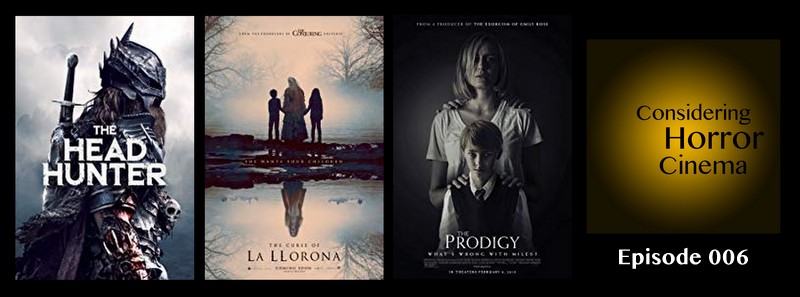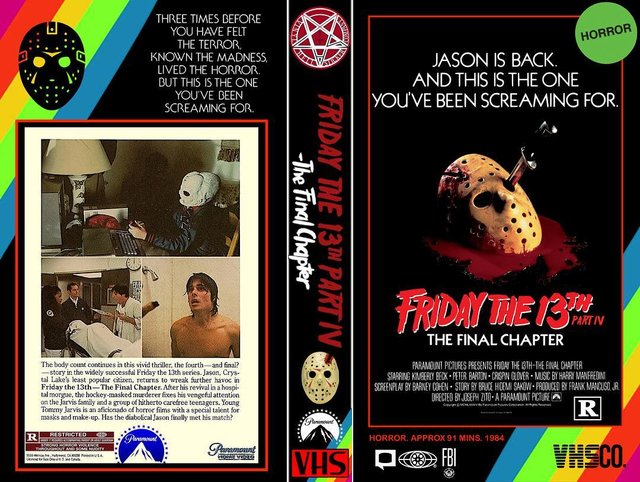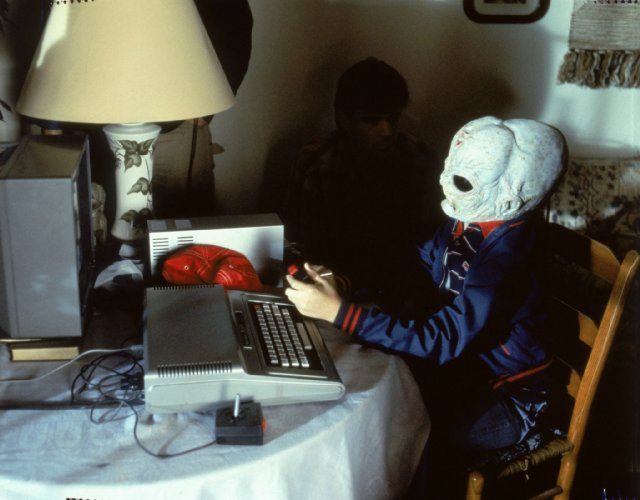Podcast: Play in new window | Download
Thanks to a very generous donation by Sean Smith and an inspiring voicemail from Greg “The Gray Man” Bensch, here is an impromptu BONUS episode of Considering Horror Cinema. I am your late-night Horror host, Jay of the Dead, and I have three, brand-new 2019 Horror movies to review for you. Coincidentally, all three films share a common theme of “Taken Children.” That wasn’t planned. It just happened.
During Episode 006, I discuss a notable film that’s a must-see Horror flick this year called The Head Hunter (2019). And I bring you reviews of the wide theater releases, The Prodigy (2019) and The Curse of La Llorona (2019).
For those who join me to consider some Horror cinema, I delve into a few important distinctions. During these reviews I explore the creation of monsters. I also compare and contrast the monstrous motivations of Pamela Voorhees versus those of La Llorona (and why the latter is a problematic character). We’ll also listen to The Gray Man’s voicemail and talk about some 1980s Horror VHS box art. If you dig Horror film criticism, I hope you’ll join me! Thanks for listening.
This episode is dedicated to Sean Smith and “The Gray Man,” Greg Bensch.
Remember, feel free to call my new voicemail number at (801) 215-9704 or email me at ConsideringTheCinema@gmail.com or post a comment. Be sure to join me for my two upcoming episodes — January through April 2019 recap, as well as another huge, long-form Horror episode where you’ll get tons of Horror movie reviews — a “Horror movie blitz”!
SHOW NOTES: Considering Horror Cinema Ep. 006
[ 00:00:00 ] – Introduction
– Dedication
– Agenda
[ 00:01:49 ] – The Head Hunter (2019)
Jay of the Dead = 8 ( Buy it! )
[ 00:15:41 ] – The Prodigy (2019)
Jay of the Dead = 6.5 ( Rental )
[ 00:22:24 ] – The Curse of La Llorona (2019)
Jay of the Dead = 6.5 ( Rental )
[ 00:37:54 ] – Listener Feedback
– Voicemail from The Gray Man
[ 00:53:10 ] – Wrap-Up
– Thank you to the generous donors who are supporting my Considering the Cinema Podcast, including Sean Smith, Adam in Chicago, Eric Herman, German R, Lance Smith, Rob Booker, Joshua G. and Shane W.
— Coming up next in Episode 007: January to April 2019 recap!
– Teasers for the next Considering Horror Cinema episode: Pet Sematary (2019), Jay’s new zombie segment, VHS Horror movie review from 1977, and an insane Horror mini review blitz!
– Wrap-Up
Links for this episode:
On Twitter: @ConsiderCinema
Website / Podcast: ConsideringTheCinema.com
Email: ConsideringTheCinema@gmail.com
Voicemail: (801) 215-9704
Letterboxd: Letterboxd.com/ConsiderCinema




That photo is pure nightmare fuel.
I can totally see that from a kid’s perspective. And yet, it is “head-shaped,” right? But it’s also “unnatural,” and unnatural is unnerving. -J
Hi Jay – Thanks so much for this episode! “The Head Hunter” sure sounds like it’s for me. I look forward to checking that out soon.
I agree 100% with what you said on this (and the previous) episode about the strength of Pamela Voorhees in “Friday the 13th” helping to make it a memorable movie (and differentiate it from its contemporaries – “Black Christmas” and “Halloween”).
Being a horror writer, I consider villain motivation often. Villains do evil things, though they should be relatable, motivated, competent, and it helps to show a little of their human side, too. This all reads somewhat counter-intuitively, yet without the audience emotionally buying into the villain, there is less emotional investment in the hero who tries to overcome the obstacles set up by the villain. Emotional investment can elevate a narrative to a more universal level.
Villains are usually the antagonists in movies and literature, though it gets even more interesting when you have a protagonist villain. Horror fiction — especially short fiction — is an excellent platform for these character types. Here’s a link to a free-to-read spy thriller flash fiction piece I wrote with protagonist villains – in case anyone reading is interested in an example: https://flashfictionmagazine.com/blog/2018/05/30/perros-fieles/
Thanks man! I look forward to the next episode.
Best,
VV
Hi Victor,
Thanks for the great comment. Let me know what you think of “The Head Hunter” once you see it.
I love what you said, and I agree. A villain with sympathetic motivation helps to enable the story to have a more interesting hero. Here’s what I mean: If we can understand the villain’s sympathetic reasons for doing evil, at least on some level, then that gives the hero a degree of conflict to overcome and wrestle with, in order to stop the villain and restore justice. This happens all the time in vigilante stories. In fact, Commissioner Gordon in Nolan’s “Dark Knight” trilogy lives on that very fence (though Batman is not a villain, of course). But he is a criminal.
It reminds me of real-life situations where a kidnapper only gets 10 years in prison (rather than being locked in a room with both of the kidnapped victim’s parents). Justice doesn’t always seem quite “just” enough. So, the hero’s arc is deepened and enriched, I think, by having to deal with the fact that the villain does have some legitimate reasons for his wicked pursuits.
When you mentioned protagonist villains, I immediately thought of Thanos. It was either Sal Roma or Redcap Jack who brought it to my attention that, in “Infinity War,” the Avengers were actually the antagonists and Thanos was the protagonist. I mean, really, since the heroes are usually playing defense to the villain’s “world domination offensive,” whether it’s a Bond villain or Cobra or a super villain, this protagonist villain is probably more common than I consciously realize.
But our perspective is almost always positioned inside the heroes’ camp, so by default, we assume that their defensive struggle is the center ring.
Thanks for listening and sharing your thoughts! Always good to hear from you.
-J
At this point in time, I have not watched The Curse of La Llorona, so my stance here could change in the future.
When it comes to the logic as to why the spirit would go after children and how you had a problem with it, Jay, to me there is some logic there. This woman had her heart broken by her fella and in a moment of sheer heartbreak, she did something truly terrible that she instantly regretted. Regretted so badly that she (I think?) immediately then killed herself. Since she wasn’t exactly happy at the time of her death, we get the standard “Spirit can not rest” issue.
Could she go after her husband and the woman he shacked up with? Sure, but would killing them calm her spirit? I’d say no since at this point, her husband cheating is the secondary heartbreak to the immediate heartbreak of her kids’ deaths. Her spirit is pissed off and unhappy that her life was ruined in every possible way. Since she’s no longer human, any compassion she may have had as a living being is gone. All that’s left is pure anger.
Now this woman’s spirit is left to roam the worlds having to see all of these happy families getting to have what she’s unable to have. She may have been killing kids for 300 years, but she’s a spirit, what does time matter to her? All she cares about is trying to bring her kids back to life and if that means killing every single child for the rest of humanity, than so be it since she’s clearly going nowhere and the children she’s killing are less deserving of life because they have a happy home and her children were robbed of it.
300 years is a long time. That’s close to a dozen generations since her lifespan and if she’s been killing children all of those years, would a spirit even notice the faces anymore, instead just seeing each child as yet another faceless victim?
If horror movie franchises has taught me anything, it’s that after a while, a killer no longer needs much of a reason to go after a victim. A killer will immediately go after those that were directly playing a role in their misfortune, but by the fourth movie, the killer is going after a teen and his friends because the teen’s uncle happened to be the mailman for a coworker of one of the original victim’s girlfriend.
Ha ha. I love it. And ultimately, I agree with everything you wrote. I guess the heart of my complaint is that the exposition of the film tells us that she started killing everybody’s children in hopes of “redeeming” the lives of her own children. (Not sure if that was the exact wording, but that’s the gist.)
There’s nothing in this lore that would even lead La Llorona to believe that such a “trade” or redemption would be possible. So, I think that’s why it all seemed so nonsensical to me. But I agree with everything else you wrote. Evidently, she just became a numb, killing machine, as you’ve suggested. At any rate, it is unnatural for a mother to kill her children, and that’s why it’s scary to me.
Thanks for writing, and let me know your thoughts if you end up watching this movie. -J
It does sound as if maybe they didn’t explain things well enough to make it clear why the spirit thinks she can bring her kids back through the death of the living kids. I can’t say for sure without seeing the movie though.
“At any rate, it is unnatural for a mother to kill her children, and that’s why it’s scary to me.”
Is it unnatural though? The statistics for parents killing their children is downright chilling to the point that the #1 cause for a child’s murder is by their parents’ hands with mothers having a slightly higher percentage for doing it than fathers. It’s the scariest thing of all, the people that should be looking out for the safety and well being of their children the most, are on average the ones most likely to do them harm.
That is horrifying for sure. But statistically speaking, judging by how many children have successfully survived their parents against how many children haven’t, I would say that kids who are killed by their parents are still the outliers in the grand scheme of the world’s population.
But yes, I take your point. That is terrifying! But I think we find it to be so because it seems so unthinkable (aka “unnatural”) to us that a mother would ever do such a thing. (I like this discussion!)
-J
After watching The Curse of La Llorona, I have some new thoughts on the logic of the ghost going after kids to try and bring her own kids back.
Unless I missed something, which is very possible as I found the movie to be pretty dreadful, the ghost was only going after Linda Cardellini’s kids solely because that other mom prayed and prayed for the ghost to take Cardellini’s kids as punishment for Cardellini’s unintentional role in her own sons’ deaths. That’s it.
For me, one of the biggest flaws of the movie is that it just felt like a normal ghost movie that was forced into being a tale of La Llorona and as part of the Conjuring universe. At no point did it ever truly feel like the 70s to me. It’s so thinly connected to the Conjuring universe that the priest from one of the spinoff movies is the sole connector. I wouldn’t go as far as to say it’s a case of whitewashing, but it did feel as if they tried to take this epic Mexican ghost lore and Americanize it as much as they could while still including just as much Hispanic influence to keep it as La Llorona. After watching the movie, I went on Wiki to read up on the legend and it’s so much more interesting than what was presented in this cheap jump scare fest.
At least according to Wiki, the logic of La Llorona makes complete sense. The whole idea is that after drowning her sons, she came to her senses and returned to the water to try and save them, but they were nowhere to be found. She then died shortly afterward. Her spirit is trying to get into heaven, but she’s being refused entry until she can find her sons. Since she’s a spirit, she’s not exactly aware of what’s fully going on, so she’s constantly roaming the lands looking for her sons, and when she finds children, she mistakenly thinks that they’re her sons, drowns them, and then tries to bring them to the gates of heavens as a show of “See! I found them!” only to be alerted that they’re not her sons. At least in the legend, I don’t think she’s supposed to be aware that she’s killing these kids. Instead, thinking that she finally found her sons, she needs to put them back in the state that they’re expected to be in. Since they died being drowned, they need to be wet.
Granted, this is just the Wiki article so I’m likely getting a very stripped down explanation, but it makes her a more tragic character. Betrayed by the man she loved, did something horrific in that pain of the betrayal, was emotionally destroyed by it, and now is forced to forever roam the land because she’s no longer alive, but can’t enter the land of the dead until she finds her sons. Meanwhile, she’s already trying to beg for forgiveness for what she does, but because she’s awful at mistaking other kids for her own, she’s only doing more and more damage.
Sounds more logical than the movie.
It also occurs to me that in some weird way, I relate to La Llorona. There’s been so many times that I had a small problem (La Llorona’s husband cheating) and tried fixing it (La Llorona drowning her sons), only for it to cause a bigger problem (La Llorona realizing she killed her sons), which I then tried to fix (La Llorona drowning other children), only to cause even more problems (La Llorona failing to be accepted into heaven since they’re not her kids), ect. A few years ago, there was a time that I had one light out on the range above my stove and in trying to sort it out, by a couple of days, I would have no power in the house or the garage, freezing in the winter. Haha. Her case of things going from bad to worse may be more extreme than I’ve been through, but I can completely relate to the frustration of everything going to hell and everything you do to try to fix it makes it worse.
Wow. This comment sort of blew me away, Sal. Thanks for taking the time to write it.
First of all, I completely agree with you. I think the “real legend” that you recounted here is much creepier than what is depicted in the movie. There’s more “soul” to it. Actually, I feel like it makes La Llorona even more of a sympathetic antagonist, which as I noted in Episode 001 of this podcast, empowers and enriches a character. You’re exactly right when you say it makes her an even more tragic character: Deep Sorrow or Deep Rage. Yep, this “monster” has the magic formula. Seems like it was a bit fumbled in the execution.
Your other point about how downward spiraling can be indicative and reflect the unraveling that often occurs in real life hit home with me, too. I resemble that scenario, as well. I think it’s tapping in to that same phenomenon that occurs whenever you have “a bad day.” One thing goes wrong in the morning, so it affects one’s attitude and colors one’s world to the point that bad things seem to keep happening one right after another. Yeah, I don’t know what to call it, but there is something to the concept of a downward spiral, and I think you’re exactly right. That’s what’s happened with this character. A dark comedy that I love is “Very Bad Things” (1998). The downward spiral happens in that story, too, and I love it. Great comment, Sal! Thank you!
-J
Just wanted to give a quick shout out and say thanks for all the great content, really digging the podcast. Also a big thank you for the recommendation of The Head Hunter, a movie I definitely would have missed out on otherwise. Even though most of the action takes place offscreen, which normally drives me insane, I felt like it was handled very well in this one. The film did a lot for me in building suspense with all the right payoffs. And it definitely had heart. That ending though….
Ha ha. I know, right? “The Head Hunter” is bleak, and I love that! I agree that it has heart. You can tell some genuine Horror fans who love the genre made that film. It is innovative and fresh. Thanks for your kind words about this podcast, Justin. I’m glad you’re digging the show, and I appreciate you giving it a try. I’ve got some fun episodes coming up, so keep listening! -J
Thank you Jay of the Dead! This is a fantastic podcast, so every episode is appreciated!